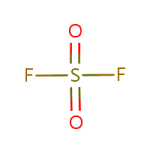
Abstract
The potent greenhouse gas sulfuryl fluoride (SO2F2) is increasingly used as a fumigant, replacing methyl bromide, whose structural and soil fumigation uses have been phased out under the Montreal Protocol. We use measurements on archived air samples and in situ observations from the Advanced Global Atmospheric Gases Experiment (AGAGE) and a box model of the global atmosphere to show a global increase of SO2F2 mole fraction from 0.3 ± 0.02 to 2.5 ± 0.08 ppt along with a global increase in emissions from 0.5 ± 0.4 Gg yr-1 to 2.9 ± 0.4 Gg yr–1 from 1978 to 2019. Based on a hybrid model incorporating bottom-up industry data and a top-down downscaling approach, we estimate the spatial distribution and trend in SO2F2 regional emissions between 2000 and 2019 and propose that the global emissions increase is driven by the growing use of SO2F2 in structural fumigation in North America and in postharvest treatment of grains and other agricultural products worldwide.
Plain Language Summary
Sulfuryl fluoride (SO2F2) is a potent greenhouse gas that has been used increasingly in fumigation since the global phase-down in the nonquarantine/preshipment use of methyl bromide under the Montreal Protocol. Despite its potential to warm the climate, there is great uncertainty surrounding the magnitude and location of SO2F2 emissions, which limits our ability to target emissions mitigation measures. We have used atmospheric observations from the Advanced Global Atmospheric Gases Experiment to show that global emissions increased from close to zero in the early 1980s to ?2.4 Gg yr?1 in 2019. We find that the primary source of these global emissions in 2019 was structural fumigation in North America, but that the increase over the last two decades has also been driven by the growing use of SO2F2 in postharvest treatment of crops in many countries around the world.
Data Availability Statement
AGAGE measurements that were used for this research are available in these in-text data citation references: Prinn, Weiss, Fraser, et al., 2000, 2018 (https://agage2.eas.gatech.edu/data_archive/). Observations from archived air samples used for this research are included in Mühle et al., 2009, their Section 2.3. Note that the spatial distribution of total, SF and PT SO2F2 emissions over the 20-year period is available from https://osf.io/b6mwr/.
*Abstract online at https://agupubs.onlinelibrary.wiley.com/doi/abs/10.1029/2020JD034327
